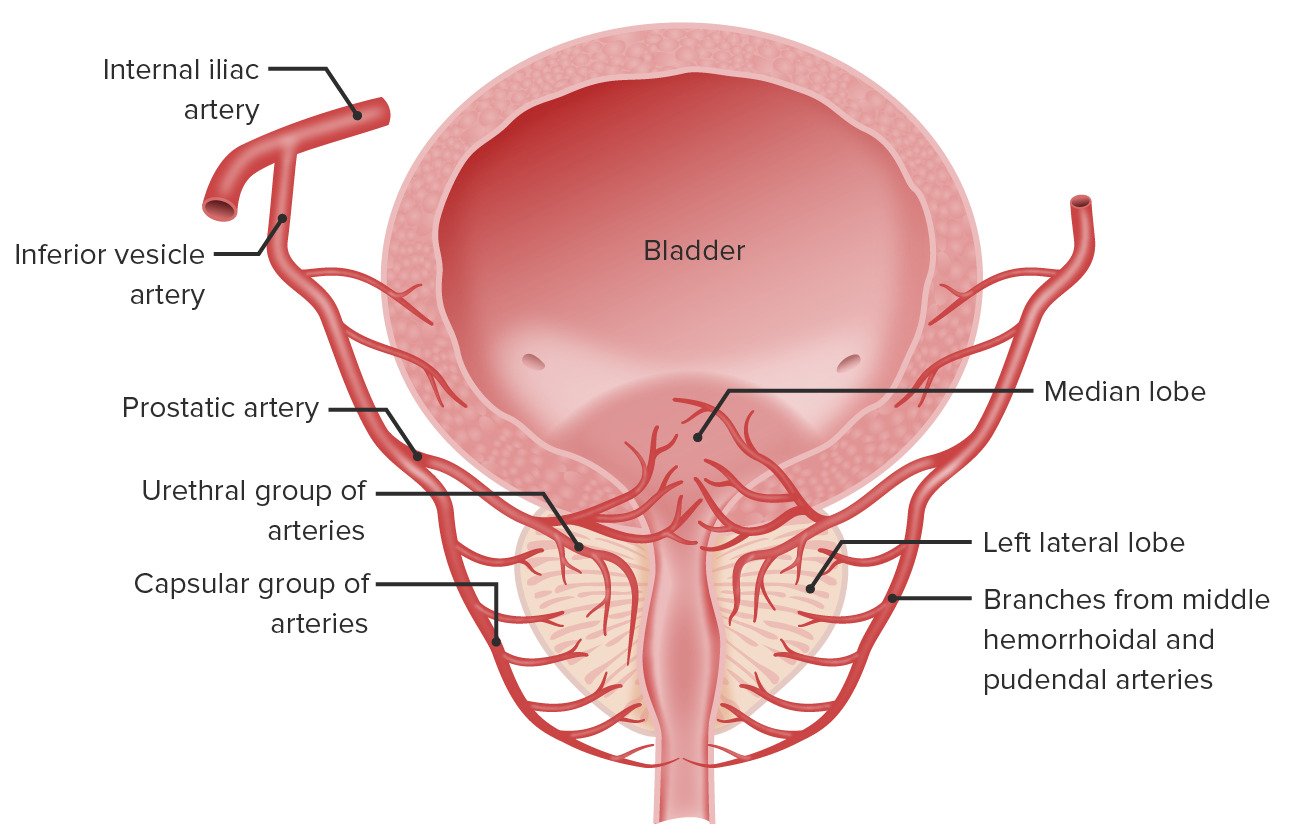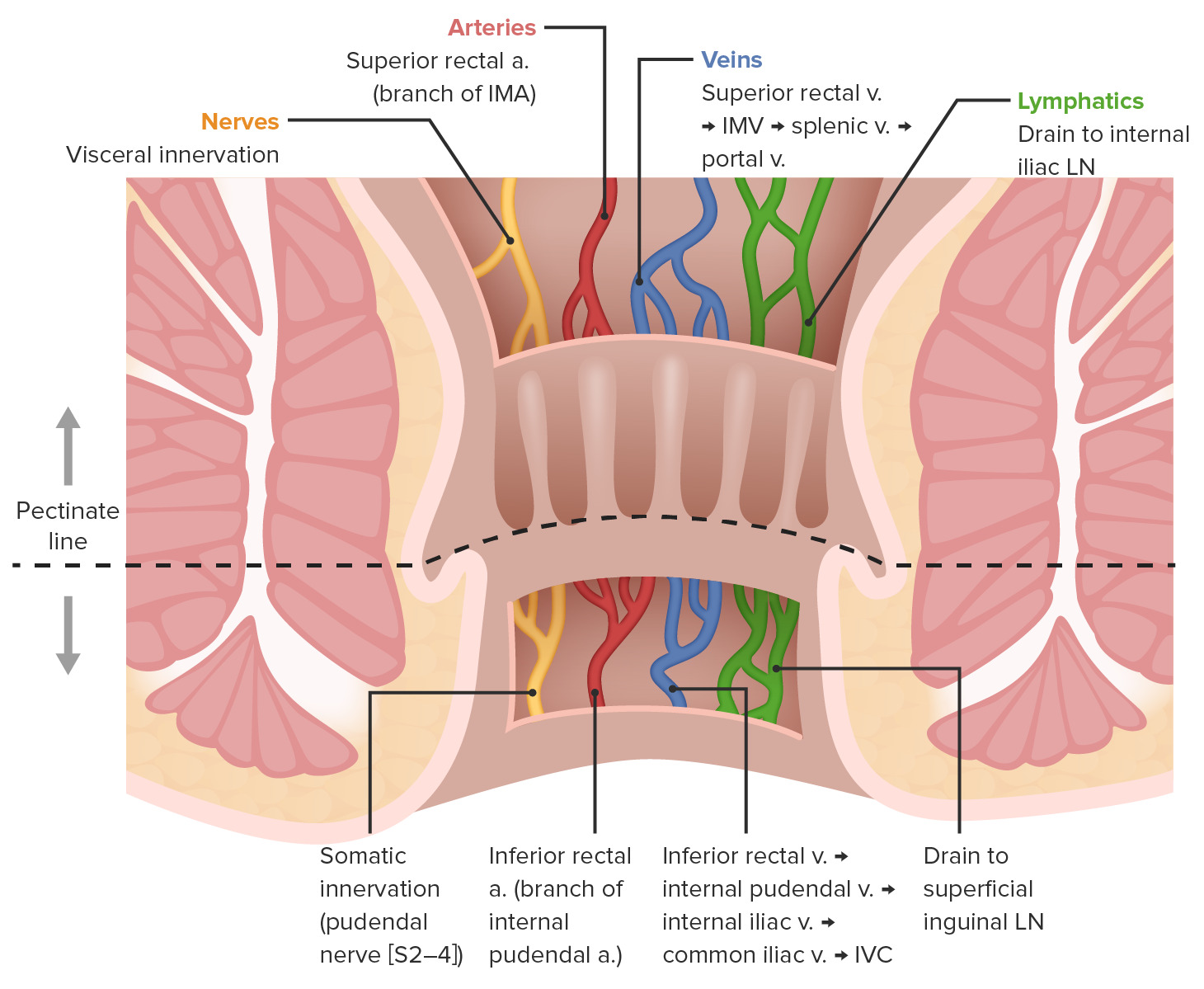Playlist
Show Playlist
Hide Playlist
Anatomy of the Rectum and Anus
-
Slides Anatomy of the Rectum and Anus.pdf
-
Download Lecture Overview
00:01 Now let's turn our attention to the rectum and the anus. 00:05 So, here we can see again, the picture we should be familiar with so far. 00:09 Anteriorly, we have the pubic symphysis, and then posteriorly we have the sacral bone and the coccyx. 00:15 And here we can see inferiorly of the rectum. 00:18 We have levator ani. 00:20 Levator ani are some specific muscles of the pelvic floor. 00:23 We'll come back to them later on. 00:25 But inferiorly importantly, we have levator ani, which has an opening that allows the rectum and the anus to pass feces out of the internal environment. 00:35 Anterior to the rectum, we have the urinary bladder, And then also anteriorly but more inferiorly we have the prostate. 00:42 And those two structures form the anterior boundary of the rectum. 00:46 If this was a female specimen, then what we would have in front of the rectum middle-ante-area would not be the blood of the prostate, but it would be the vagina and the uterus. 00:56 So, look back at the previous images to just make sure you were aware of those boundaries. 01:02 Now, if we need to talk about the peritoneum in relation to the rectum that is slightly complicated. 01:08 And that's partly because we have that transition of the transverse, descending, sigmoid and parts of the colon, then becoming the rectum or having different associations with the peritoneum. 01:22 So, if you remember the complex nature of say the transverse mesocolon, which had its intimate relationship with the peritoneum, then we had the descending colon, which was secondarily retroperitoneal. 01:35 Then the sigmoid colon had that sigmoid mesocolon, and that continues down into the rectum. 01:41 So, the upper third of the rectum is actually covered on both the anterior and lateral sides, as that mesocolon of the sigmoid colon is now tapering away. 01:53 So the rectum doesn't have a mesentry, but it's covered as we transitioned from sigmoid mesocolon down to being completely subperitoneal. 02:03 We have that transition. 02:04 So, in the upper third of the rectum, we have a transition from full mesocolon around the sigmoid colon, to just the peritoneum covering the anterior and lateral aspects. 02:15 As we then go to the middle third of the rectum, the peritoneum only covers the anterior aspect and the lateral aspects of the rectum do not have a covering of peritoneum. 02:26 So we've gone from the upper third lateral anteriorly. 02:30 The middle third, we just have anterior and then the lower third is not covered by peritoneum. 02:37 We are now deep within the pelvis. 02:38 And the peritoneum is only covering the superior aspects of those organs as they protrude from the pelvic cavity into the abdominal cavity. 02:48 Some important peritoneal relations of the rectum. 02:52 Here we can now see the rectum internal structure. 02:55 So, here we're looking at it as if we're looking from anterior aspect, but the bladder in the male and the bladder, vagina, and uterus in the female have been removed. 03:05 And we can see we have the rectum passing down. 03:09 We can see it's got the anal canal, which is a tapering down of the rectum to allow feces to exit the body. 03:16 We have the rectosigmoid junction where we have the transition from sigmoid colon to the rectum. 03:22 That's where you'd have that transition from sigmoid mesocolon to peritoneum, only covering the anterior and lateral aspects. 03:30 On the internal surface of the rectum, we have some rectal folds. 03:35 These helped to hold the feces in position and prevent the feces just falling through the rectum into the anus. 03:42 So we have some folding of the internal wall of the rectum. 03:46 We have rectal folds, and then we have the rectal ampulla which allows the storage of feces and this can alter in size as the feces occur in this region. 03:56 If we then look at the transition from the rectum down to the anus, we can see we have some anal columns. 04:02 So these are foldings of the mucosal membrane of the rectum. 04:07 And then either side of those we have these deep little pouches called the anal sinuses. 04:11 And these can fill with mucus to ease the movement of feces from the internal environment out into the external environment with defecation. 04:20 We have the transition from the rectum all the way down into the anal canal via the pectineal line. 04:26 And this is an important landmark because this identifies the transition embryologically of the endoderm, which forms the gut tube. 04:36 Everything from the stomach, large intestine, small intestine. 04:40 This is the transition from the endoderm to the ectoderm. 04:44 And this is where we then have the anal canal. 04:47 What we've done is we've then put together a simple table which helps to highlight the difference between the anal canal it's features above and below that pectinate line. 04:57 So here we're going to see that pectinate line, which is that transition between the upper aspects of the anus and the lower parts of the anus, as we have that transition from rectum down to anus. From endoderm down to ectoderm. 05:11 And this is important because we have differences in the epithelium above the pectinate line and below the pectinate line. 05:18 So, in the gut tube, we have columnar epithelium. 05:21 Obviously, below their pectinate line, we have stratified squamous epithelium. 05:26 This will go from being non-keratinized to keratinized as we enter the perianal skin. 05:32 Blood supply is from the superior axial artery or the middle and inferior rectal arteries if you're above or below. 05:39 A similar pattern for venous drainage, Lymphatic drainage will be by the internal iliac lymph nodes or the superficial inguinal lymph nodes depending if you're above or below. 05:50 The nerve supply is important because endoderm is supplied by the autonomic nervous system. 05:56 So here we have the inferior hypogastric plexus, which we're not consciously in control of. 06:01 Whereas the process of defecation is important on the somatic nervous system. 06:06 Therefore, below the pectinate line relaxation of the external anal sphincter we'll come to that later on, is controlled by the pudendal nerve, which we have control over similar to micturition. 06:18 Hemorrhoids and the different type of hemorrhoids are very different as well. 06:21 Internal, if they're above the pectinate line, and external, if they're below the pectinate line. 06:27 Because they're external below the pectinate line and associated with the pudendal nerve, these has somatic nerves so you'll be able to feel pain from these external hemorrhoids. 06:38 And then as we've just been alluding to differentiation in embryological origin from the endoderm and the ectoderm gives rise to these very different features above and below the pectinate line of the anal canal. 06:51 And these are important to remember both clinically and anatomically.
About the Lecture
The lecture Anatomy of the Rectum and Anus by James Pickering, PhD is from the course Anatomy of the Large Intestine.
Included Quiz Questions
Which structures are anterior to the rectum? Select all that apply.
- Urinary bladder
- Prostate
- Vagina
- Levator ani
- Coccyx
What statement describes the relationship between the peritoneum and the rectum?
- The middle third of the rectum is covered anteriorly.
- The upper third of the rectum is covered anteriorly and posteriorly.
- The lower third of the rectum is covered anteriorly.
- The middle third of the rectum is covered laterally.
- The lower third of the rectum is covered laterally.
What marks the transition point from the endoderm to the ectoderm?
- Pectinate line
- Anal sinuses
- Anal columns
- Anal canal
- Valves of Houston
Customer reviews
5,0 of 5 stars
| 5 Stars |
|
5 |
| 4 Stars |
|
0 |
| 3 Stars |
|
0 |
| 2 Stars |
|
0 |
| 1 Star |
|
0 |





